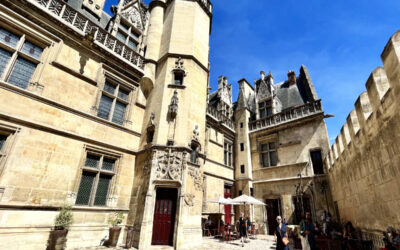Paris, with its rich history and vibrant streets, can seem like a dream come true. But getting around the city can be slightly more complicated than you might think.
As someone who had to wheel a double baby stroller and elderly grandparents around Paris for years, I can tell you it can be tough. From crowded streets, packed metros, and inaccessible routes, Paris doesn’t make it easy. So let’s look at the various options, shall we? Allons-y!
Metro
- fast and cheap
- large network all across the city
- certain lines are very busy during rush hour
- often have delays
- not handicap, stroller, luggage accessible
The Paris Métro is the quickest way to travel around the city. Tickets cost around €2-3 and can be purchased from ticket vending machines located in every station.
If you plan on using the metro frequently, you can buy a carnet (a pack of 10 tickets) for around €18, offering a slight discount. Paper tickets are no longer available, but your 10 ticket carnet can be loaded onto a Pass Navigo, which is a card shaped like a credit card.
You can also buy a Day pass, if you are planning several trips all across the city.
There are several types of Pass Navigo, but tourists who are here for a limited period of time will want a Pass Navigo Easy, as it does not require a photo to be attached.
Otherwise, for weekly passes or a monthly subscription, you will have to buy a Pass Navigo Découverte.
To purchase metro tickets, go up to the counter at an RATP station and explain what type of ticket you want. Once you have your tickets, follow the signs, hop on a train, and you’re good to go.
I should note that very few metro stations in Paris meet accessibility standards. And even if the station has elevators and/or escalators, they are often not working due to delinquence.
Unfortunately for people with handicaps, but also those with strollers, luggage, elderly, etc. that means the metro may not be the best way to get around Paris.
Busses
- above ground with nice views
- crowded
- often stuck in traffic
- same price as metro
- make sure your ticket is valid when changing busses (depends on ticket)
- supposed to be handicap accessible
If you prefer traveling above ground, Paris’s bus network is a convenient option. A single journey ticket costs the same as the metro and can be bought on your phone on with small change directly from the driver when you board the bus.
If you plan on using buses frequently, consider purchasing a day pass on your Pass Navigo Easy, so that you can easily change busses.
I should note that while the busses are supposed to be handicap accessible for wheelchairs, this may not always be the case. The RATP outlines what what is accessible and what is not here.
However, I should note that the drivers do not lower the access ramp for strollers or luggage, so you will have to carry that those on yourself.
Enter from the back of the bus and then make your way forward to the driver to pay your ticket. (This is of course not always feasible if the bus is crowded, but you will get a monetary fine if you don’t scan your ticket.)
Taxi
- will drop you at your exact destination
- more pricey than public transport
- can get stuck in traffic
- can be difficult to flag one done
For more comfort, Paris has plenty of taxis. Taxis charge a starting fare of €2.40, with additional charges based on distance traveled and time spent in traffic. You can hail a taxi on the street or find them at designated taxi ranks throughout the city.
Hop-on-Hop-off-Bus
- flexible and worry free
- going to all the main attractions
- more expensive
- limited amount of time
- can get stuck in traffic
For a guided tour with flexibility, hop-on-hop-off buses in Paris are a good alternative.
The circuits of the hop-on-hop-off busses cover all the major attractions, giving a running commentary in English, French, German, Spanish, and a handful of other languages. It also gives you the flexiblity to spend more time at a particular location than others.
The drawback to the busses is that they can get stuck in traffic, as is the case for all vehicles in Paris.
Tickets for a one-day pass start from €34-60 including various options such as boat cruises and entrance tickets to certain attractions. Tickets can be purchased online or from ticket vendors at major tourist attractions.
RER, Tram & Train Lines
- fast
- large network all across Ile-de-France
- certain lines are very busy during rush hour
- often have delays
- not handicap, stroller, luggage accessible
For destinations outside the city such as the Palace of Versailles or Disneyland Paris, the RER and suburban train lines are the only way to access them on public transport.
You can take the RER within Paris as well, but the metro is generally less confusing and more practical. This is because not all RER trains go to all the stops on the line. So you have to properly access which train is arriving and where it is going before getting on.
Tickets for RER journeys are priced according to the distance traveled, ranging from €3 to €10. You can purchase tickets from ticket vending machines or ticket counters located in RER stations.
I do not recommend the RER however if you are more than 3 people, as it will be the same price and easier for you to take a taxi or a private tour instead. You can find private tour companies to Disney and Versailles here.
Rideshare (Uber, Marcel)
- not as regulated as taxis
- prices can vary
- can get stuck in traffic
App-based rideshare services like Uber and Marcel also operate in Paris. Prices vary depending on the time of day, distance traveled, and demand.
Payment is made through the app, and you can track your ride in real-time. You can use your same app and credit card that you use in your own country, making adoption easy.
Riverboat cruises
- covers all main scenic sights in 1-3 hours
- without traffic issues
- can be pricey
If you are short on time, and even if you are not, you can enjoy Paris from a different perspective with a cruise along the Seine River.
Prices for riverboat cruises vary depending on the duration and type of cruise. There are day cruises, night cruises, cruises serving food, sunset cruises and more along the Seine River.
There are also Canal Saint Martin cruises around the Right Bank of Paris. Tickets can be purchased online or from ticket booths along the riverbanks.
Bicycle
- flexible
- plenty of bikelanes
- requires some skill
- cheap
For eco-conscious travelers, cycling is a great option. Rental prices for bicycles start from around €10 per day and can be found at numerous bike rental shops throughout the city.
There are also pick-up-and-drop-off Velib stations all across Paris. The procedure is as follows:
- Sign up: Register online or at a Velib station kiosk to get a Velib card.
- Choose your plan: Select a short-term (1 or 7 days) or long-term (monthly or annual) subscription.
- Find a bike: Locate a bike at any Velib station using the app or online.
- Unlock the bike: Tap your card or scan the QR code on the bike’s panel.
- Ride responsibly: Follow traffic rules and use hand signals for turns.
- Return the bike: Dock the bike at any Velib station with available space until it’s securely locked.
- Check your ride history: Monitor your usage through the Velib app or website to make sure that you have been properly noted as having returned your bike.
Car
- can be pricey
- private cars are blocked on certain streets
- difficult to park
- roads are congested
- great for day trips outside Paris
Driving in Paris can be very complicated, as the city’s mayor wants to actively discourage car traffic. Parking can be difficult, and many streets are congested or have been closed to car traffic.
This can make it rather difficult to follow your desired itinerary, and even locals like me don’t try to drive too often in Paris.
While driving in Paris can be challenging, having a car can be useful for day trips. Rental prices for cars start from around €30 per day and can be arranged through various rental companies.
Foot
- free
- discover the real city
- can be difficult if you don’t have a lot of time
Finally, don’t forget the joy of exploring Paris on foot. It’s free and allows you to discover the city’s charm at your own pace.
The French way to explore is indeed the idea of “flâner“, where you go towards whatever catches your interest. Rather than a list of tourist attractions, this is the real Paris where the locals live.




